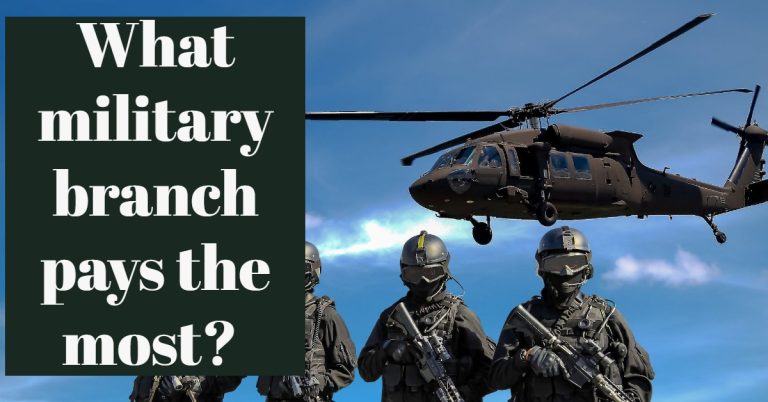
The financial remuneration offered by the various branches of the military is a critical consideration for prospective service members. In contrast to civilian occupations, military salaries are based on a more structured scale that takes into account rank, years of service, and specific job functions. As of 2025, determining which military branch pays the most necessitates a thorough examination of these various elements, as well as consideration of additional benefits and allowances that contribute to the overall compensation package.
At the outset, it is imperative to delineate the primary branches of the military: the Army, Navy, Air Force, Marine Corps, and Coast Guard. Each branch possesses unique mission objectives, cultures, and financial structures. Therefore, their payment scales diverge significantly, influenced by factors such as service commitment, geographic location, and operational demands.
In terms of base pay, all branches adhere to a standard military pay scale, initially determined by the Department of Defense. This scale, known as the Military Pay Chart, outlines annual salary increments based on rank—enlisted personnel and officers earn differing amounts based on their respective tiers. For instance, an entry-level E-1 (Army Private) will earn considerably less than a Senior Chief Petty Officer (E-8) in the Navy.
Despite this standardized pay scale, discrepancies emerge between branches, largely driven by the nature of duties and bonuses associated with specific military occupational specialties (MOS). For example, certain technical roles and positions in high-demand fields—such as cyber operations or aviation—frequently receive additional incentives that may enhance total compensation significantly.
The Army, for instance, offers various incentives to boost recruitment and retention in critical roles. These include bonuses for skilled positions, such as linguists, medical personnel, and special operations forces. Moreover, the Army has continually increased its base pay in recent years to remain competitive in attracting top talent.
The Navy, particularly renowned for its operational capacities at sea, also provides appealing compensation packages. Sailors serving in advanced technical roles or aboard submarines may receive substantial bonuses, along with specialized training allowances and benefits that can amplify the overall financial remuneration beyond the base salary. The sea pay, submarine pay, and other operational bonuses frequently place Navy personnel at a significant financial advantage relative to other branches.
Examining the Air Force, one can observe that it has long been considered the branch with some of the most competitive salaries. Its emphasis on technological prowess and advanced weaponry translates into high demand for skilled professionals in engineering, intelligence, and cyber warfare. Consequently, specialized career fields within the Air Force often receive hefty enlistment and retention bonuses. These compensation strategies ensure that members are adequately rewarded for their expertise and commitment.
Conversely, the Marine Corps, while traditionally regarded as one of the most elite branches, tends to offer slightly lower average salaries compared to the Air Force and Navy. However, it’s crucial to note that the Marine Corps highly emphasizes leadership development and rapid career progression, which can subsequently lead to substantial increases in pay over time.
Furthermore, the Coast Guard presents its unique financial incentives that are often overlooked. While it may not have the same scale of bonuses as the Navy or Air Force, the Coast Guard offers competitive pay, particularly for personnel located in higher cost-of-living areas. Additionally, the Coast Guard’s dedicated public service aspect can attract individuals who prioritize a sense of civic duty alongside their financial considerations.
Beyond base pay and bonuses, one should consider the comprehensive benefits package that accompanies military service. Health care, educational benefits, housing allowances, and retirement options contribute significantly to the overall financial compensation. The GI Bill, for instance, is a salient factor influencing many individuals’ decisions to join the military as it covers tuition and housing costs for veterans pursuing higher education. This large-scale benefit substantially increases the overall attractiveness of military service.
When evaluating which branch pays the most, it is also vital to consider the intangibles associated with military life, including job security, retirement plans, and the potential for personal development through rigorous training and diverse experiences. While the immediate salary might serve as a compelling factor in recruitment, the long-term benefits and career progression opportunities extend far beyond initial paychecks.
In conclusion, pinpointing the military branch that provides the highest pay is multifaceted and influenced by numerous variables. While the Air Force and Navy often emerge as frontrunners regarding overall compensation, the Army offers enticing incentives for specialized roles and high-demand positions. The Marine Corps, while slightly lagging in base pay, fosters rapid career advancement, and the Coast Guard presents competitive salaries tailored to its unique maritime responsibilities.
Ultimately, understanding the totality of compensation—including bonuses, benefits, and growth potential—renders a clearer picture of the financial landscape across military branches. This thorough examination enables potential service members to make well-informed decisions that align with their personal and professional objectives.
